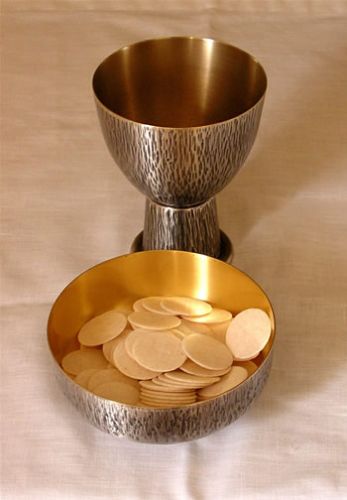 Yes, gentle readers, you know you might be in a bit of trouble when you open up a story about the intricate details of Catholic liturgy and there is a photo showing a priest saying prayers at the altar and the caption says:
Yes, gentle readers, you know you might be in a bit of trouble when you open up a story about the intricate details of Catholic liturgy and there is a photo showing a priest saying prayers at the altar and the caption says:
The Rev. Rob Clements leads Communion at Mass on Thursday at All Saints Newman Center in Tempe.
So, is that supposed to be that he is leading the Mass? That he's saying the consecration prayers in the Mass? Just about the only words that don't work are that he is "leading Communion at Mass."
A puzzlement. And a sign of things to come, according to several GetReligion readers who sent me the URL for and Arizona Republic story that ran under this headline: "Phoenix Diocese's limit on wine a major change in Mass."
This is a case in which, if one reads the whole story, it's possible to figure out some of what is going on – kind of. For some reason, this diocese has decided that a revised, more traditional (I think both sides of this fight would agree that the intent was to get closer to older and more literal language translated from the post-Vatican II Latin source texts) version of the liturgy requires priests to stop serving consecrated wine to members of the congregation, offering them only the consecrated bread instead.
The story explains that serving the consecrated bread alone is the normal practice for most Catholics around the world. However, receiving both elements has been common in the United States.
OK, with all of that as a background, try to make sense out of this lede:
The Phoenix Diocese will stop offering consecrated wine for Communion at most Masses, a change considered one of the most fundamental to Roman Catholic Church customs in decades.
A diocesan statement said the change was being made based on Bishop Thomas J. Olmsted's understanding of the church's new translation of the Mass, called the General Instruction of the Roman Missal, and other church documents.
However, no other diocese in the country is known to be following suit, the U.S. Conference of Catholic Bishops told The Arizona Republic.
You could read the lede as saying that priests in this diocese will only offer unconsecrated wine, etc., etc. Some readers, briefly, thought wine would no longer be consecrated at all.
It's possible that the lede merely needs this addition (marked in italics):
Priests in the Phoenix Diocese will stop offering consecrated wine to members of their congregations during most Masses, a change considered one of the most fundamental to Roman Catholic Church customs in decades.
OK, Catholic readers, would that fix the problem right up top?
I know that there are other issues in the story, as well. Take this, for example.
Communion, a sacrament that symbolizes a spiritual union with Christ, is a widespread practice among Christian churches, following the commands of Jesus in the Gospels. But the Catholic Church believes the bread and wine used during the service actually are transformed into the body and blood of Christ.
The word "symbolizes" is problematic for any reference in a sentence that supposedly address life in "Christian churches" – period. Obviously, the Eucharistic elements are more than symbolic for the Orthodox, for Anglicans and some others. The precise doctrines may be slightly different, but the bread and the wine are much more than "symbols" (especially for the Catholics and the Orthodox).
I could go on and on (and I urge readers to do so).
But I think it's crucial, for other reporters covering this story, to know the best way to express the concepts combined in that lede.
The other obvious question: What change is actually mandated in the documents with this revised translation? I have to admit that I am completely confused.
The diocese issued a statement and a question-and-answer sheet to explain the move. New norms, or guidelines, that came out this year, the statement said, expanded the offering of Communion under the form of wine for most of the world, "but in the Diocese of Phoenix, the new norms call for the practice of less frequent distribution of Holy Communion under both kinds than the faithful may have been accustomed."
Uh, say what? A little help here?
This story is over my head or under it or beside it or something. I think the story, more than anything else, needed some clear commentary from an expert on the revised translation and the orders released with it – a true, national and global level voice of authority.
